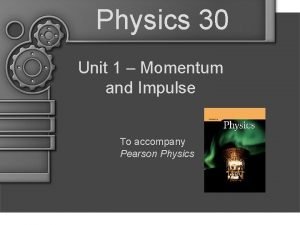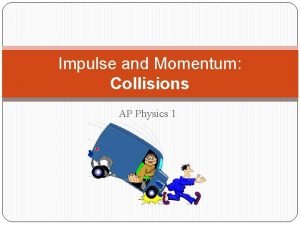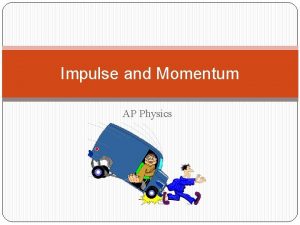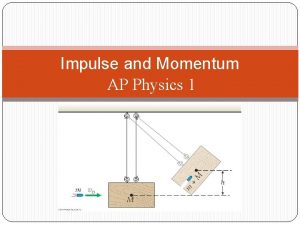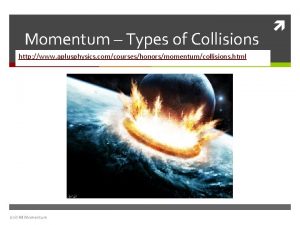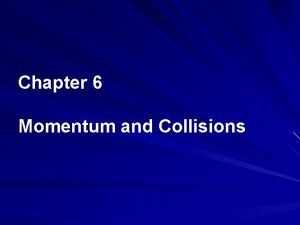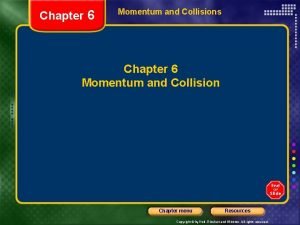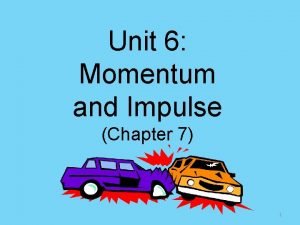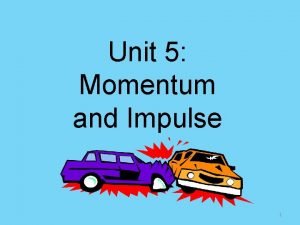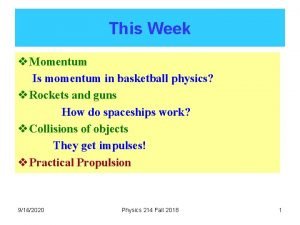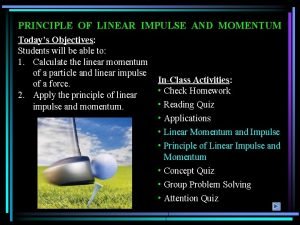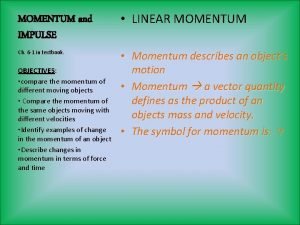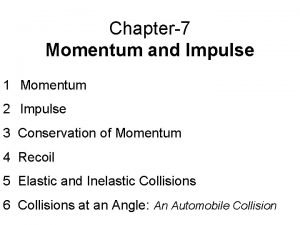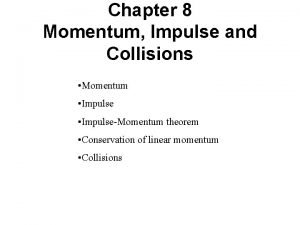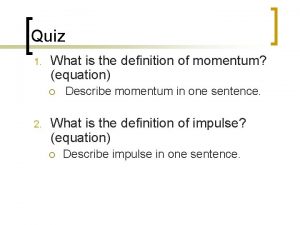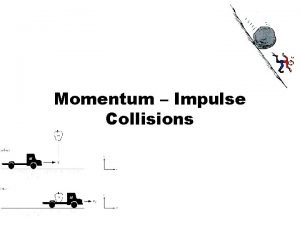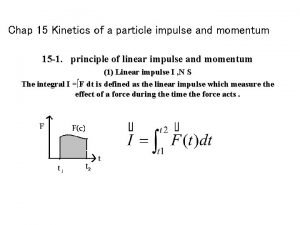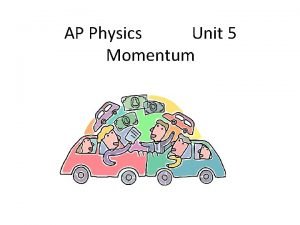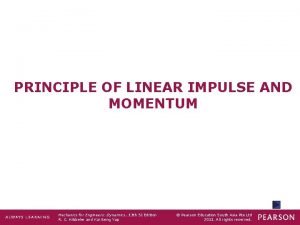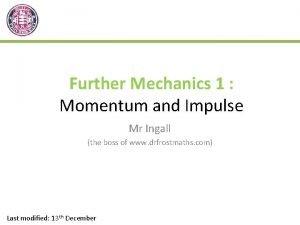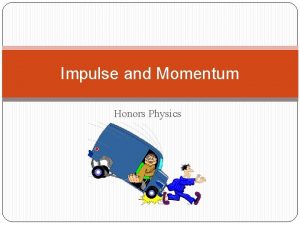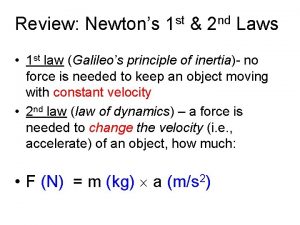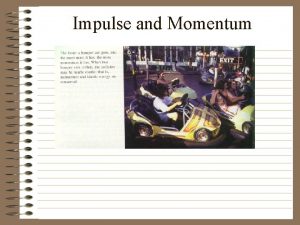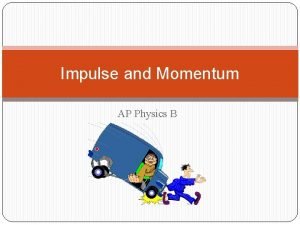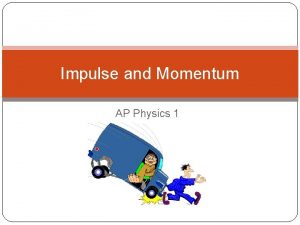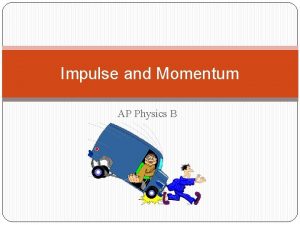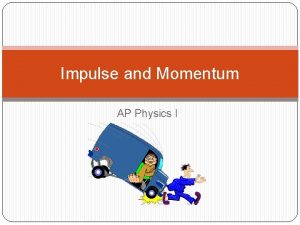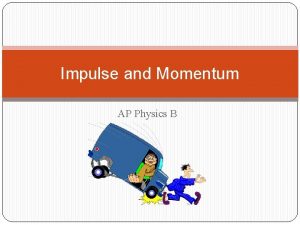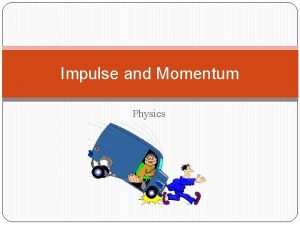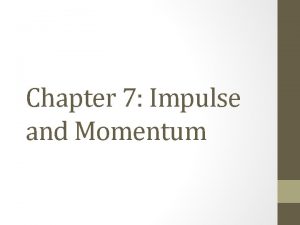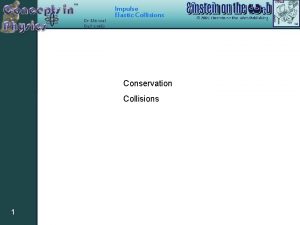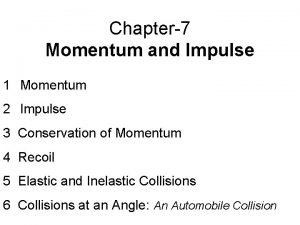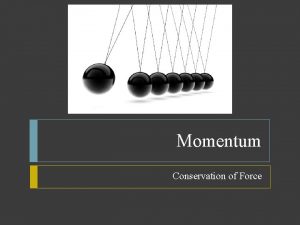Collisions Impulse and Momentum AP Physics 1 M




































- Slides: 36

Collisions: Impulse and Momentum AP Physics 1 M. Dimler

What to Expect from this Unit 1. 2. 3. 4. 5. Momentum Impulse-Momentum Theorem Conservation of Momentum Collisions (Elastic, Inelastic, Perfectly Inelastic, and Explosion) 6. Elastic Collisions-Conservation of KE 7. Collisions in 2 -D 8. Center of Mass

Momentum • A moving object’s momentum is the product of its mass and velocity. • Momentum is a vector quantity, and the direction of momentum is in the direction of motion. • Units of momentum – kg∙m/s

Momentum • The rate of change in momentum is equal to the net force. • This can be shown using Newton’s 2 nd Law.

Impulse • Impulse is the change in an object’s momentum, which is also equal to the net force on the object multiplied by the time during which the force acts. • Impulse is in the direction of net force. • Impulse can be expressed in N∙s or kg∙m/s.

Impulse-Momentum Theorem • Impulse can be calculated using the Impulse. Momentum Theorem • Impulse can also be determined by quantifying the area under a net force vs. time graph.

Impulse • The impulse tells us that we can get the same change in momentum with a large force acting for a short time, or a small force acting for a longer time. • This is why you should bend your knees when you land; why airbags work; and why landing on a pillow hurts less than landing on concrete.

Practice Problem • Force of a tennis serve: For a top player, a tennis ball may leave the racket on the serve with a speed of 55 m/s (about 120 mph). If the ball has a mass of 0. 060 kg and is in contact with the racket for about 4 ms, estimate the average force on the ball. Would this force be large enough to lift a 60 kg person?

Practice Problem • A 2 -kg coconut falls from the top of a tall tree, 30 m above a person’s head. The coconut strikes and comes to rest on the person’s head. a) Calculate the magnitude of the momentum of the coconut just before it hits the person in the head.

Practice Problem • A 2 -kg coconut falls from the top of a tall tree, 30 m above a person’s head. The coconut strikes and comes to rest on the person’s head. b) Calculate the magnitude and direction of the impulse experienced by the coconut in colliding with the person’s head?

Practice Problem • A 2 -kg coconut falls from the top of a tall tree, 30 m above a person’s head. The coconut strikes and comes to rest on the person’s head. c) The person’s head experienced a force of 10, 000 N in the collision. How long was the coconut in contact with the person's head? A) Much more than 10 seconds B) Just a bit more than one second C) Just a bit less than one second D) Much less than 1/10 of a second

Practice Problem • A 2 -kg coconut falls from the top of a tall tree, 30 m above a person’s head. The coconut strikes and comes to rest on the person’s head. d) In a different situation, explain how it could be possible for an identical coconut dropped from the same height to hit the person's head, but produce less than 10, 000 N of force.

Challenge Practice Problem Bend your knees when landing: a) Calculate the impulse experienced when a 70 kg person lands on firm ground after jumping from a height of 3. 0 m. b) Estimate the average force exerted on the person’s feet by the ground if the landing is stiff-legged, and again… c) … with bent legs. Note: With stiff legs, assume the body moves 1. 0 cm during impact, and when the legs are bent, about 50 cm.

Conservation of Momentum Note: In any system in which the only forces acting are between objects in that system, momentum is conserved. This effectively means that momentum is conserved in all collision.

Conservation of Momentum • Law of Conservation of Momentum: The total momentum of an isolated system of objects remains constant.

Conservation of Energy and Momentum in Collisions • Momentum is conserved in all collisions. • Collisions in which kinetic energy is conserved as well are called elastic collisions, and those in which it is not are called inelastic collisions.

Elastic Collisions • Here we have two objects colliding elastically. We know the masses and the initial speeds. • Since both momentum and kinetic energy are conserved, we can write two equations. This allows us to solve for the two unknown final speeds.

Inelastic Collisions • With inelastic collisions, some of the initial kinetic energy is lost to thermal or potential energy. It may also be gained during explosions, as there is the addition of chemical or nuclear energy. • A completely inelastic collision is one where the objects stick together afterwards, so there is only one final velocity.

Explosion (ex. Balloon, Rocket) Momentum conservation works for a rocket as long as we consider the rocket and its fuel to be one system, and account for the mass loss of the rocket.

Practice Problem A car on a freeway collides with a mosquito, which was initially at rest. Justify all answers thoroughly. a) Did the total momentum of the car-mosquito system increase, decrease, or remain the same after the collision? b) Did the momentum of the mosquito increase, decrease, or remain the same after the collision? c) Did the momentum of the car increase, decrease, or remain the same after the collision?

Practice Problem A car on a freeway collides with a mosquito, which was initially at rest. Justify all answers thoroughly. d) Which changed its speed by more in the collision, the car or the mosquito? (Or did they change speed by the same amount? ) e) Which changed its momentum by more in the collision, the car or the mosquito? (Or did they change momentum by the same amount? ) f) Which experienced a greater impulse in the collision, the car or the mosquito? (Or did they experience the same impulse? )

Practice Problem A car on a freeway collides with a mosquito, which was initially at rest. Justify all answers thoroughly. g) Which experienced a greater magnitude of net force during the collision, the car or the mosquito? (Or did they experience the same net force? )

Practice Problem • Ballistic Pendulum: The ballistic pendulum is a device used to measure the speed of a projectile, such as a bullet. The projectile, of mass m, is fired into a large block of mass M, which is suspended like a pendulum, where M>m. As a result of the collision, the pendulum and projectile together swing up to a max height, h. Determine the relationship between the initial horizontal speed of the projectile (v) and the max height (h).

Group Quiz Problem Car A has a mass of 1, 500 kg and travels to the right with a speed of 20 m/s. Car B initially travels to the left with a speed of 10 m/s. After the vehicles collide, they stick together, moving left with a common speed of 5 m/s. Justify all answers thoroughly. a) Calculate the mass of Car B. b) This collision is not elastic. Explain why not. c) Describe specifically a collision between these two cars with the same initial conditions but which is not elastic, and in which the cars bounce off one another. d) Is the collision elastic when Car B remains at rest after the collision?

Collisions in 2 -Dimensions (or 3) • http: //www. khanacademy. org/science/physics/linearmomentum/momentum-tutorial/v/2 -dimensionalmomentum-problem

Center of Mass • Momentum is a powerful concept not only for analyzing collisions, but also for analyzing the translational motion of real extended objects. In (a), the diver’s motion is pure translation; in (b) it is translation plus rotation. There is one point that moves in the same path a particle would take if subjected to the same force as the diver. This point is called the center of mass (CM).

Center of Mass “CM” The general motion of an object can be considered as the sum of the translational motion of the CM, plus rotational, vibrational, or other forms of motion about the CM.

Center of Mass • For two particles, the center of mass lies closer to the one with the most mass: • where M is the total mass.

Center of Mass vs. Center of Gravity • The center of gravity is the point where the gravitational force can be considered to act. It is the same as the center of mass as long as the gravitational force does not vary among different parts of the object.

Experimentally Determine Center of Gravity • The center of gravity can be found experimentally by suspending an object from different points. The CM need not be within the actual object – a doughnut’s CM is in the center of the hole.

Center of Mass and Translational Motion • The total momentum of a system of particles is equal to the product of the total mass and the velocity of the center of mass. • Applying Newton’s 2 nd Law: The sum of all the forces acting on a system is equal to the total mass of the system multiplied by the acceleration of the center of mass

Center of Mass and Translational Motion This is particularly useful in the analysis of separations and explosions; the center of mass (which may not correspond to the position of any particle) continues to move according to the net force.

Motion of the Center of Mass • Example: Imagine that an astronaut on a spacewalk throws a rope around a small asteroid, and then pulls the asteroid toward him. Where will the asteroid and the astronaut collide? • Example: A toy rocket is in projectile motion, so that it is on track to land 30 m from its launch point. While in the air, the rocket explodes into two identical pieces, one of which land 35 m from the launch point. Where does the first piece land?

Summary • Momentum of an object: • Newton’s second law: • Total momentum of an isolated system of objects is conserved. • During a collision, the colliding objects can be considered to be an isolated system even if external forces exist, as long as they are not too large. • Momentum will therefore be conserved during collisions.

Summary • • In an elastic collision, total kinetic energy is also conserved. • In an inelastic collision, some kinetic energy is lost. • In a completely inelastic collision, the two objects stick together after the collision. • The center of mass of a system is the point at which external forces can be considered to act.

Bullet Block Experiment Veritasium • https: //www. youtube. com/watch? v=v. WVZ 6 APXM 4 w • https: //www. youtube. com/watch? v=BLYoy. Lcd. GPc
 Physics 03-02 potential energy and conservative forces
Physics 03-02 potential energy and conservative forces Physics 30 momentum and impulse
Physics 30 momentum and impulse Ap physics momentum and impulse
Ap physics momentum and impulse Impulse definition physics
Impulse definition physics Impulsive force
Impulsive force What is momentum in physics
What is momentum in physics Aplusphysics momentum-conservation answer key
Aplusphysics momentum-conservation answer key Types of collisions
Types of collisions A roller coaster climbs up a hill at 4m/s and then zips
A roller coaster climbs up a hill at 4m/s and then zips Does an elastic collision conserve momentum
Does an elastic collision conserve momentum Chapter 6 momentum and collisions
Chapter 6 momentum and collisions Momentum is conserved in all collisions
Momentum is conserved in all collisions Unit 6 momentum and impulse
Unit 6 momentum and impulse Units of momentum
Units of momentum Basketball impulse and momentum
Basketball impulse and momentum Principle of linear impulse and momentum
Principle of linear impulse and momentum Linear impulse and momentum
Linear impulse and momentum Importance of momentum and impulse
Importance of momentum and impulse Momentum and impulse poem
Momentum and impulse poem Momentum is a vector quantity
Momentum is a vector quantity Importance of momentum and impulse
Importance of momentum and impulse Momentum and impulse formula sheet
Momentum and impulse formula sheet Momentum s.i unit
Momentum s.i unit Units of momentum
Units of momentum Impulse units
Impulse units What is the change in momentum
What is the change in momentum Define linear momentum
Define linear momentum Impulse and momentum
Impulse and momentum 5.b impulse
5.b impulse Kinetics of a particle: impulse and momentum
Kinetics of a particle: impulse and momentum Unit 5 momentum 5.a center of mass
Unit 5 momentum 5.a center of mass Dynamics impulse and momentum solved problems
Dynamics impulse and momentum solved problems Principle of angular impulse and momentum
Principle of angular impulse and momentum Further mechanics 1 unit test 1 momentum and impulse
Further mechanics 1 unit test 1 momentum and impulse Impulse-momentum relationship
Impulse-momentum relationship What is impulse
What is impulse Momentum in terms of energy
Momentum in terms of energy

